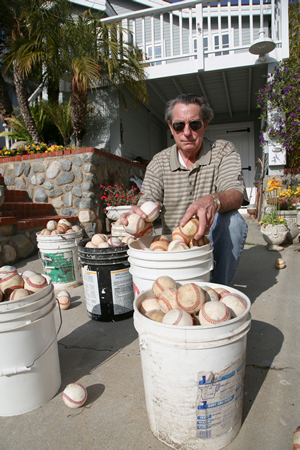
Updated March 27:
After 12 years of hearing complaints from neighbors who have collected more than 500 over-the-fenc baseballs, the school board is considering installing a higher fence around the Laguna Beach High School baseball field.
Resident David Nelson lives on St. Ann’s Drive in the direct line of “power alley” homeruns. He’s collected $20,000 from the Laguna Beach Unified School District for seven property claims in seven years, he said. The claims are due to dented cars, broken windows and damaged skylights from errant baseballs.
Neighbors, high school baseball players, their fans and Little League coaches filled the board room during a special public study session Thursday, March 5, to discuss safety concerns about baseballs flying over the current 30-foot-high retaining fence. Baseball players sat on the floor, still wearing their grass-stained uniforms from an earlier game.
The two “hot spots,” according to the district’s report, are “power alley” down the left side of the field, an area known for right-handed homeruns, and the foul-ball zone behind the dug-out along Wilson Street.
Following an hour and a half of reports and comments, the school board asked the district’s facilities director, Jeff Dixon, to ferret out costs for 50-foot to 80-foot high retaining fences, including retractable fencing, along St. Ann’s Drive and Wilson Street. Formal estimates are expected to be presented at a district board meeting in April or May.
Three solutions were presented by Dixon. The other two included returning the field to its 2004 southern orientation at a probable cost of $1 million or moving high school baseball to Alta Laguna Park in the Top of the World neighborhood. “We need to have these discussions,” Dixon said at the meeting. “Everyone cares about safety and everyone cares about the integrity of baseball.”
The retractable fencing solution is one Nelson said he heard 12 years ago. He even had blueprints made for telescoping fencing, at the board’s request. The idea was benched due to view-blocking complaints from neighbors uphill from the campus, Nelson said. “What’s it going to take for them to do something before someone gets hurt?” he asked.
“We listen for the crack of a bat and then we look up,” said Nelson’s neighbor, Stephen Crawford, who also collected buckets full of errant baseballs. “Is that any way to live at your own house?”
The high school baseball field was re-oriented in 2004 to prevent homeruns from flying into the middle of the track and the football practice field. Home plate was moved from the south corner of the field to the west corner. Without negligence, the district holds no liability for injuries because flying baseballs are “normal outcomes” from a baseball field, Dixon reported to the board.
Local realtor and former high school volleyball coach Lance Stewart suggested that the district raise the fence, eliminate eucalyptus trees there and keep the baseball program at the high school. “It’s a simple fix,” he said. “Let’s move on.”
Another resident, Collin Goddard, parent of a baseball player, said property owners are well aware of the hazards of buying near a school. “We’re going to drive the high school out of here,” he said. “Where does litigiousness stop?”
During his testimony, Nelson threw a baseball forcefully at the floor. He said he wanted the board to see the unpredictability of its force and direction. The baseball team was sitting a few feet away.
One of the team’s players, senior Anthony Norelli, wearing a number 10 jersey, apologized later in the meeting for creating any danger to the school’s neighbors.
School board members, booster parents and school administrators chastised Nelson for keeping the baseballs after they flew off school property. Eight buckets of used balls, at $5 each new, where lined up in front of the school board’s conference table. They will be returned, Nelson said later, when the district resolves the problem.
“They were saying we were stealing the balls,” he said. “Once the school board shows some responsibility and comes up with and implements a solution, we will gladly give the balls back.” Supt. Sherine Smith specifically told Nelson that the baseballs he and Crawford brought to the meeting were district property.
The day after the meeting, Nelson expressed his appreciation of the baseball players’ support and apology by returning two five-gallon buckets of balls. He met with head baseball coach Michael Bair, the high school athletic director Mike Churchill and the team before practice, he said. “We thanked them for being mature, responsible and respectful,” Nelson said. “We’re not stealing the balls. The only reason we’ve collected them is to show how many are coming over and how often.”
Nelson said Thursday’s meeting left him queasy. “I walked out of that meeting, as I do every time, with my stomach all upset and feeling like I was the bad guy,” he said. “Our intention never was to move the baseball program away from Laguna Beach High School. We’re trying to prevent a tragedy.”
The retractable netting would be considered an immediate as well as a permanent solution, said board member Jan Vickers, adding that increasing the height of the fence will require review by the Division of State Architects, an expensive process.
Correction:
In the article “Schools Explore Higher Fence to Catch Power Hits” in the March 13 edition, it incorrectly stated David Nelson received $20,000 in claims from the Laguna Beach Unified School District due to damage from errant baseballs. The figure reflects 26 claims and the cumulative amount paid to several different people due to baseball-related damages.





[…] fencing or reorienting the field to avoid homeruns from causing homeowners on St. Ann’s Drive to run for cover is a priority, according to board […]